Über die Möglichkeiten abstrakter Malerei
- Post By: AnKaKronmüller
- Date:
- Category: ART, Interview
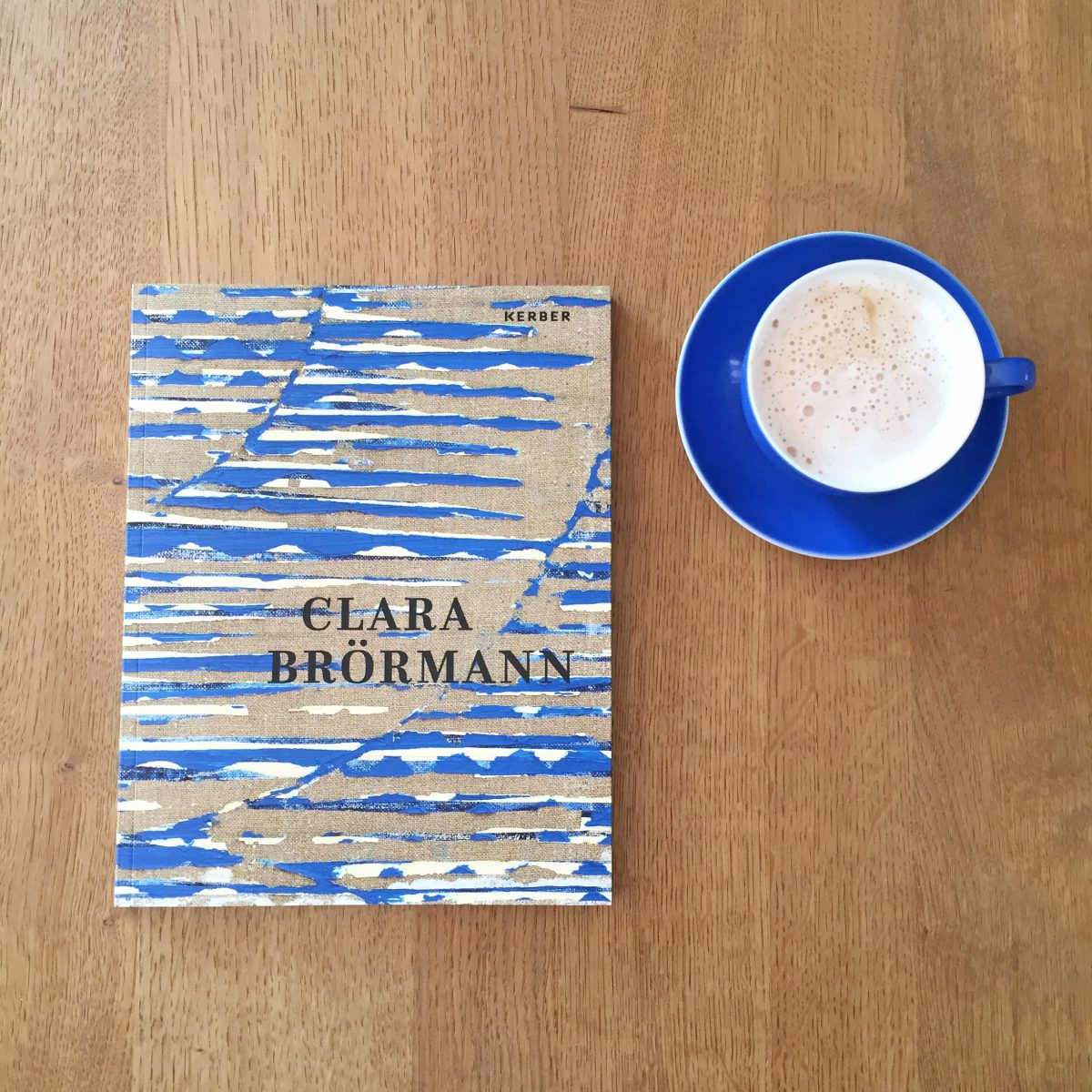
Clara Brörmann im Gespräch mit Christine Nippe
Please, scroll down for the English version!
***********************************
Christine Nippe: Für deine Malerei hast du eine ganz spezielle Technik entwickelt, die die Elemente ›Aufbauen / Konstruktion‹ und ›Zerstören / Dekonstruktion‹ enthält. Kannst du diese Technik erläutern?
Clara Brörmann: Mit dem Wort ›Technik‹ habe ich Schwierigkeiten. Das klingt wie eine vorher ausgetüftelte Handhabung. Es geht eher um eine Vorgehensweise, meine Auseinandersetzung mit dem Bild. Es ist in gewisser Weise ein Verhandeln zwischen mir und dem Bild, vergleichbar mit einem Gespräch. Während der Unterhaltung sagt jeder etwas und man kommt auf ganz neue Gedanken. Deswegen unterhält man sich ja auch. Es geht also um einen zweiten und dritten Blick. Ich ordne Farbe auf der Leinwand an und im darauffolgenden Schritt hebe ich die Komposition wieder auf. Die Bildgestaltung wird übermalt, entfernt, Teile werden herausgerissen oder abgeschliffen. Die weitere Gestaltung knüpft jedoch immer wieder an das an, was bereits auf der Leinwand ist. Meine Malerei orientiert sich also am Entstehungsprozess selbst. Ich beginne jedes Bild ohne eine Vorstellung vom Ergebnis. Das Resultat beruht auf einer Vielzahl von Entscheidungen und Prozessen des Umdenkens, ist eine vielschichtige, mehrdimensionale Malerei. Es ist ein sehr lebendiger Vorgang.
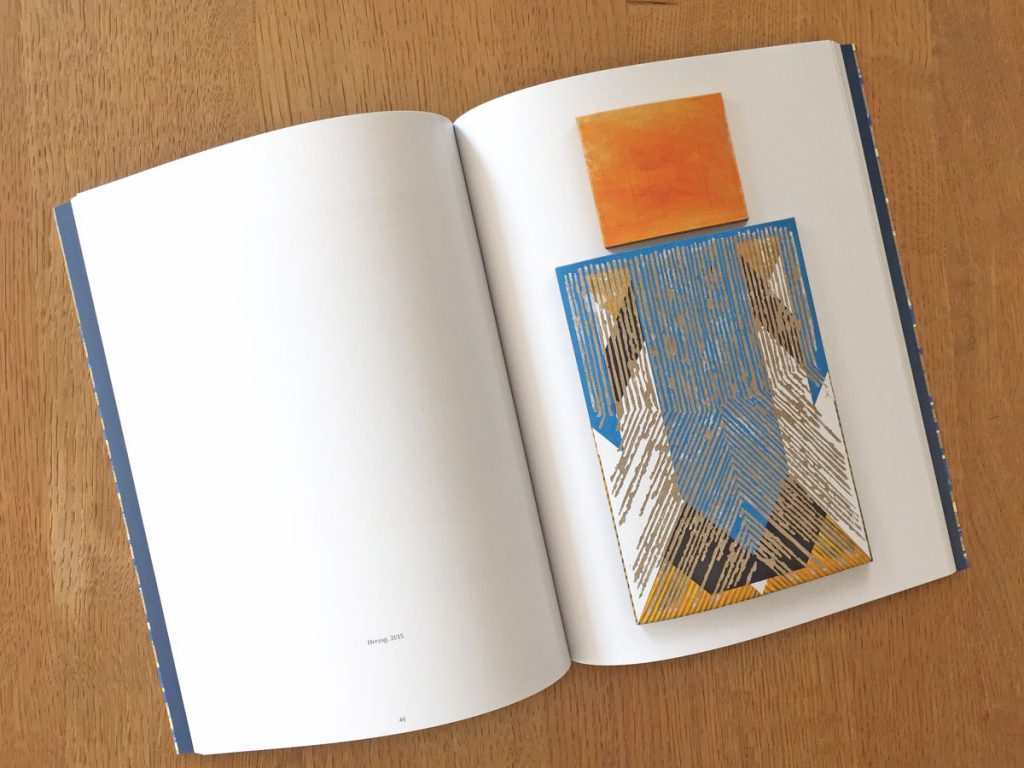
CN: Im Vergleich zu anderen zeitgenössischen Künstlern fällt mir auf, dass deine Arbeiten sich durch eine ausgesprochene Materialästhetik auszeichnen. Warum ist diese Qualität wichtig für dich?
CB: Materialisierung an sich, von Vorstellungen und Ideen, finde ich wichtig, um diese überhaupt ›greifbar‹ zu machen. Es entsteht ein Gegenstand, den man sehen und haptisch wahrnehmen kann. Und im besten Fall kann man diese Erfahrung auch noch miteinander teilen. Zudem wird die persönliche, physische Identifikation zwischen Betrachter und Künstler unterschätzt. Wenn jemand ein Bild von mir anschaut, kann er darin die Pinselspuren, also meine Gesten nachempfinden. Mit dieser ›eingeschriebenen Handlung‹ hat man dann sozusagen auch die menschliche Figur als Bezugsgröße im Bild.
CN: Kannst du beschreiben, wie du neue Arbeiten angehst? Wann bist du besonders produktiv?
CB: Grundsätzlich muss ich nur Zeit und Muße haben, um konzentriert arbeiten zu können. Eine Vorstellung davon, was ich als Nächstes machen will, entwickle ich unabhängig davon, ob ich im Atelier bin oder Geschirr spüle. Es gibt dafür keinen konkreten Zeitpunkt, sondern einen fließenden Zeitraum. Wenn ich eine Bildidee und eine Vorstellung von den Formaten habe, fange ich im Atelier an, Keilrahmen zu bauen und Leinwände zu grundieren. Und dann wird die Idee langsam konkreter.
CN: Die Idee schält sich erst langsam im Prozess heraus? Welche Rolle spielt dabei dein Atelier als Arbeitsort? Was macht es aus?
CB: Hier kann ich viel Dreck machen und habe meine Ruhe.
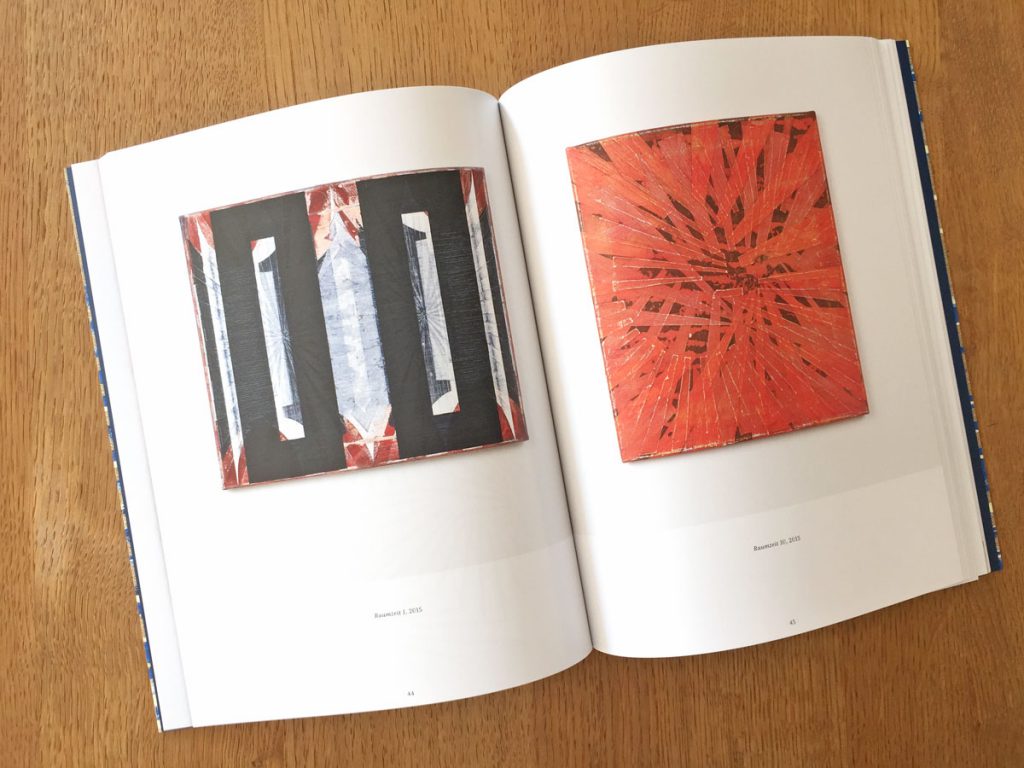
CN: Ja, man sieht hier an den Farbspuren überall, wie du dich deinem Arbeitsprozess hingibst. Farbe scheint also eine wichtige Rolle zu spielen. Sie hat ja immer etwas mit dem Gefühl, sowohl des Produzenten als auch des Rezipienten, zu tun. Aus welchem Antrieb entstehen Bilder in einer bestimmten Farbigkeit, welche Wirkung ist dir dabei wichtig?
CB: Hat Farbe wirklich immer etwas mit Gefühl zu tun? Natürlich hat sie einen Charakter und eine Stimmung. Ich könnte aber nicht sagen, dass sie mehr Gefühl beinhaltet als eine Form. Für mich ist Farbe Material, mit dem ich arbeite. Farbe ist plastisch und hat einen Körper. Kriterien wie deckend, transparent, flach, tief, warm, kalt oder kontrastierend sind ausschlaggebend für meine Wahl. Ich verwende wenig knallige, laute Farben und eigentlich keine künstlichen wie Neonfarben, ich möchte vermeiden, dass sie sich zu sehr in den Vordergrund drängen. Ich mische meine Farben nie, sondern nehme sie direkt, wie sie aus der Tube kommen. Eine Mischung kommt allerdings durch die Überlagerungen zustande.
CN: Alltagsgegenstände schreiben sich in deine Arbeit ein. Wie ist es mit anderen Künstlern, welche waren und sind für dich wichtig? Und aus welchen Gründen?
CB: Das Problem ist, dass mir jetzt Hunderttausende einfallen, die mich interessieren. Insbesondere in der Moderne: van Gogh, Munch, Duchamp, Klee, und überhaupt das Bauhaus und der Konstruktivismus. Natürlich auch die amerikanische abstrakte Malerei seit den Fünfzigerjahren. In der Berliner Gemäldegalerie gibt es ganz tolle Werke von van Eyck, Dürer, Vermeer und Caravaggio. In der zeitgenössischen Malerei fehlt mir manchmal die Tiefe und Mehrdimensionalität, sprich ein richtiger Bildraum. Interessanterweise hat mich Caspar David Friedrich auf die Geometrie gebracht und nicht die Konstruktivisten. Seine Bilder sind geometrisch aufgebaut, das heißt, es ist kein illusionistischer Ansatz, sondern ein idealisierter, was eine geistige Leistung ist. Die Geometrie hätte ich natürlich auch im Mittelalter entdecken können, mit dem ich mich im Moment vor allem beschäftige.
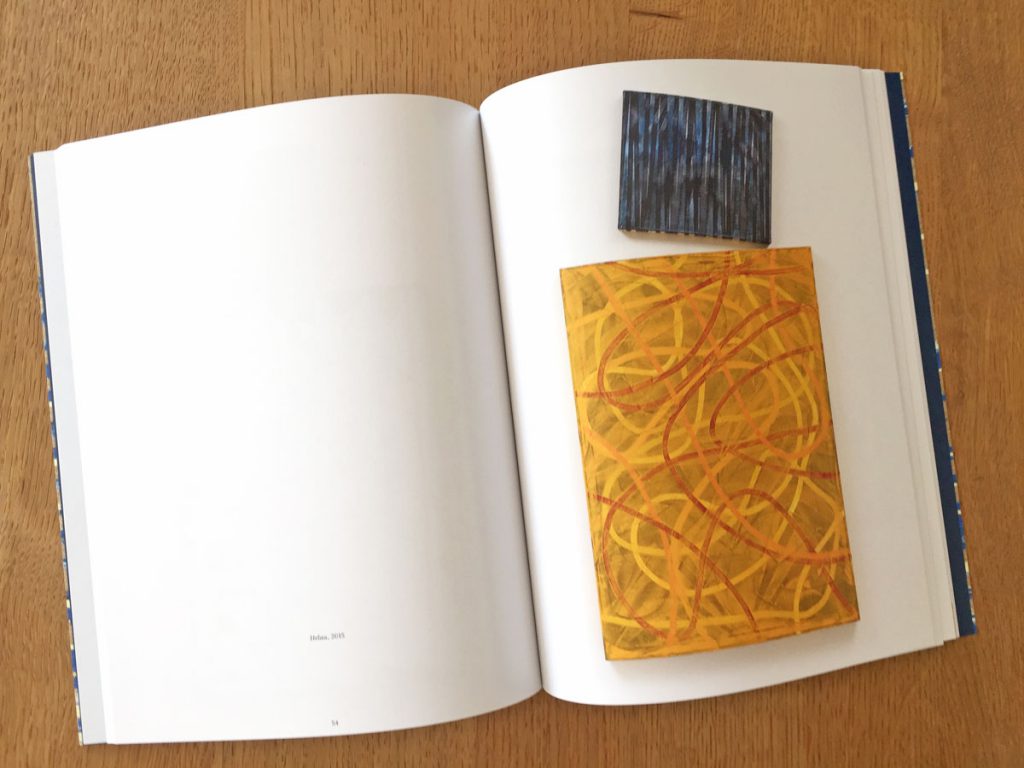
CN: Wie gehst du mit der Tradition der Malerei und dem ›Ballast‹ der Kunstgeschichte in Hinblick auf deine eigene Arbeit um? Welche Strategien helfen dir bei der Entwicklung neuer Bilder?
CB: Ich versuche, die Dinge auf meine Art zu entwickeln, ganz so, wie ich die Welt wahrnehme und verstehe. Ich hatte schon immer einen eher musikalisch- sinnlichen Zugang zu den Dingen. Gleichzeitig bin ich körperlich immer sehr involviert, also gewissermaßen Learning by Doing. Das heißt, mit allen Sinnen die Dinge zu begreifen. Der Kopf ist nicht vom Körper getrennt. Damit man sich nicht nur um sich selbst, sprich im Kreis dreht, nehme ich viel von anderen auf. Die Kunstgeschichte empfinde ich somit nicht als Ballast, sondern als Quelle. Ich finde meine eigene Lösung für Probleme, über die andere schon nachgedacht haben. Die Auseinandersetzung mit dem Material ist immer eine gute Möglichkeit, etwas zu beginnen. Das wäre dann auch meine ›Strategie‹.
CN: Was möchtest du in Zukunft angehen, hast du schon erste Ideen?
CB: In meiner kommenden Ausstellung pursuit of happines im September 2016 bei SCHWARZ CONTEMPORARY werde ich ›abstrakte Allegorien‹ zeigen. Ich habe mich von mittelalterlichen Buchmalereien aus dem 13. und 14. Jahrhundert inspirieren lassen, die für die großformatigen Arbeiten titelgebend sind. Mit Bezeichnungen wie Fortuna oder Liebende werden die Arbeiten zu Sinnbildern für zeitlose Themen. Ich bin gespannt, was für eine Wirkung die abstrakten Bilder mit diesen kulturhistorischen Bezügen haben werden. Im Grunde geht es darum, die Möglichkeiten abstrakter Malerei auszutesten. Die Frage ist, ob ein ungegenständliches Bild zu einer Allegorie werden kann? In dieser Hinsicht möchte ich auch weiterarbeiten, also die Grenzen von Bildgattungen überschreiten. Das abstrakte Bild als Landschaft, Stillleben, Porträt … alles ist möglich.
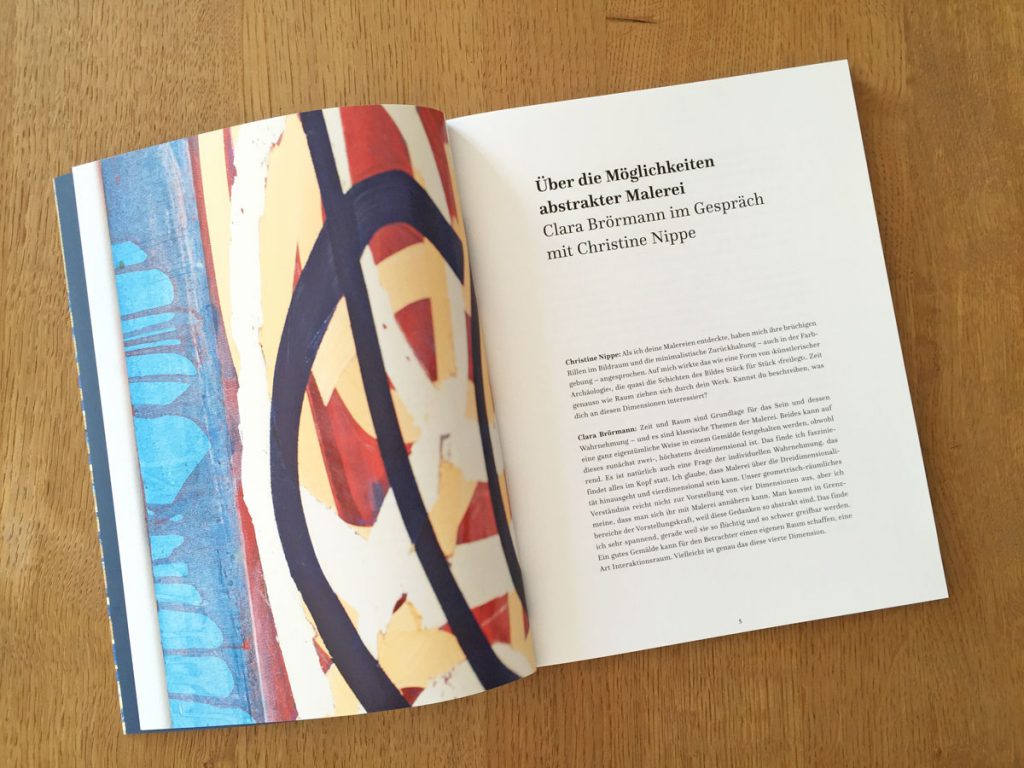
Das Gespräch wurde am 22. April 2016 in Berlin geführt und ist vollständig als Teil der Monografie ‚Clara Brörmann‘ erschienen. Das Buch finden Sie hier.
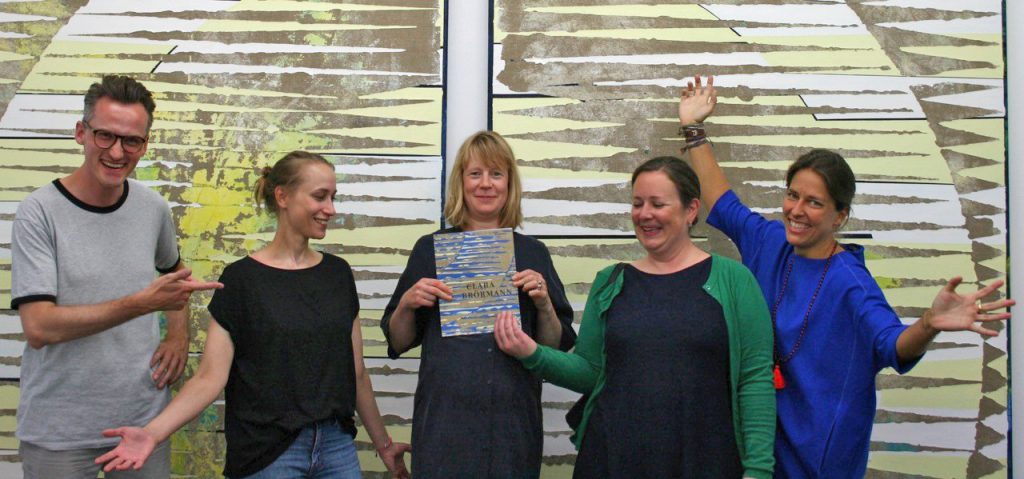
So sehen begeisterte Buchproduzenten aus! Von links nach rechts: Clemens von Lucius (Redaktion, Lektorat), Birte Kreft (Programmleitung, Kerber Verlag), Clara Brörmann, Christine Nippe und Anne Schwarz (Herausgeberin, Galeristin).
About the Possibilities of Abstract Painting
Clara Brörmann in Conversation with Christine Nippe
Christine Nippe: You’ve developed a very special technique for your paintings that contains the elements “building up/construction” and “destroying/deconstruction.” Can you explain this technique?
Clara Brörmann: I find the term “technique” problematic, because it sounds like a prescriptive approach. But what is at issue here is more my mode of working, my engagement with the painting. It is in a certain way a negotiation between me and the painting, comparable to a conversation. In a conversation, everybody says something, and then you develop completely new thoughts. That’s why you have conversations. So the point is a second and third look. I arrange paint on the canvas, and in the next step, I revoke the composition. The composition is painted over, removed, parts are pulled out or ground away. The later composition always develops what is already on the canvas. So my painting is oriented on the process of formation. I start every painting without any idea of the final result. The result is based on numerous decisions and processes of rethinking, it is a multilayered, multidimensional painting. It is a very animated process.
CN: I noticed that in comparison to other contemporary artists, your works are characterized by an expressly material aesthetics. Why is that important to you?
CB: Materialization as such, of notions and ideas, is important to make them “graspable.” The result is an object you can see, and perceive in a tactile manner. And in the best case, you can share this experience with others. I think the personal, physical identification between viewer and artist is generally underestimated. When somebody looks at one of my paintings, s/he can trace and experience the brush strokes, that is to say, my gestures. With that “inscribed action” you also have, as it were, the human figure as a reference point in the painting.
CN: Can you describe how you approach new works? When are you especially productive?
CB: Basically, all I need to be able to concentrate on my work is time and peace and quiet. My ideas for what I want to do next can come to me anywhere, in the studio or while I do the washing up. So there isn’t a concrete point in time, but rather a more fluid period of time. Once I have an idea for a painting and its format, I start making stretch frames and priming them in the studio. And then, slowly, the idea becomes more concrete.
CN: So the idea crystallizes slowly during the process? What role does the studio play here as your place of work? What’s special about it?
CB: It’s where I can mess about, and where I have peace.
CN: Yes, I can see from all the traces of paint everywhere that you really give yourself over to the process of working. So color seems to play an important role. That always has something to do with the emotions of both the producer and the recipient. What motivates a certain color palette, what effect is important to you?
CB: Does color really always have something to do with emotion? Of course it has a character and a mood. But I wouldn’t say it contains more emotions than a shape does. For me, color is a material with which I work. Color is plastic, it has a body. My choice is dictated by criteria such as opaque, transparent, flat, deep, warm, cold, or contrasting. I rarely use brash, loud colors, and not really ever artificial ones like neon paints; I don’t want them to push themselves too much into the foreground. I never mix my paints; I use them as they come from the tube. But the layering results in a mixture.
CN: So everyday objects inscribe themselves into your works. What about other artists? Who has been important for you? And why?
CB: The problem is that I can think of thousands who interest me. Especially modernist ones: Van Gogh, Munch, Duchamp, Klee, Bauhaus, of course, and constructivism. Naturally also American abstract painting since the 1950s. There are amazing works by van Eyck, Dürer, Vermeer, and Caravaggio in Berlin’s Gemäldegalerie. In contemporary painting I sometimes miss depth and multidimensionality, a proper pictorial space, if you will. Interestingly, it was Caspar David Friedrich and not the constructivists who got me to think about geometry. His paintings are geometrical structures, that is to say, it isn’t an illusionist approach, but an idealized one, which is an intellectual achievement. Of course, I could also have discovered geometry in the Middle Ages, an era that currently interests me especially.
CN: How do you deal with the tradition of painting and the “ballast” of art history with respect to your own work? Which strategies help you in developing new paintings?
CB: I try to develop things in my own way, just like I perceive and understand the world. My way of accessing things has always been more musical, or sensual. At the same time, I’m always very involved physically, learning by doing, as it were. That means grasping things with all the senses. The head isn’t separated from the body. So that I don’t just circle around myself, I take in a lot from others. Therefore I don’t see art history as ballast, but rather as a source. I find my own solutions for problems about which others have already thought. Engaging with the material is always a good way of starting. That, then, would be my “strategy.”
CN: What will you do in the future, do you have any ideas?
CB: In my next exhibition pursuit of happines in September 2016 at SCHWARZ CONTEMPORARY, I will show “abstract allegories.” I was inspired by medieval illuminations from the thirteenth and fourteenth century, which is where I got the titles for the large works. With titles like Fortuna or Liebende, the works become allegories for timeless topics. It will be interesting to see what kind of effect the abstract paintings with these references to cultural history will have. Basically, I’m interested in exploring the possibilities of abstract painting. The question is whether a non-figurative painting can become an allegory. That’s where I want to keep working: to transgress the limits of genres. The abstract painting as a landscape, still life, portrait… everything is possible.
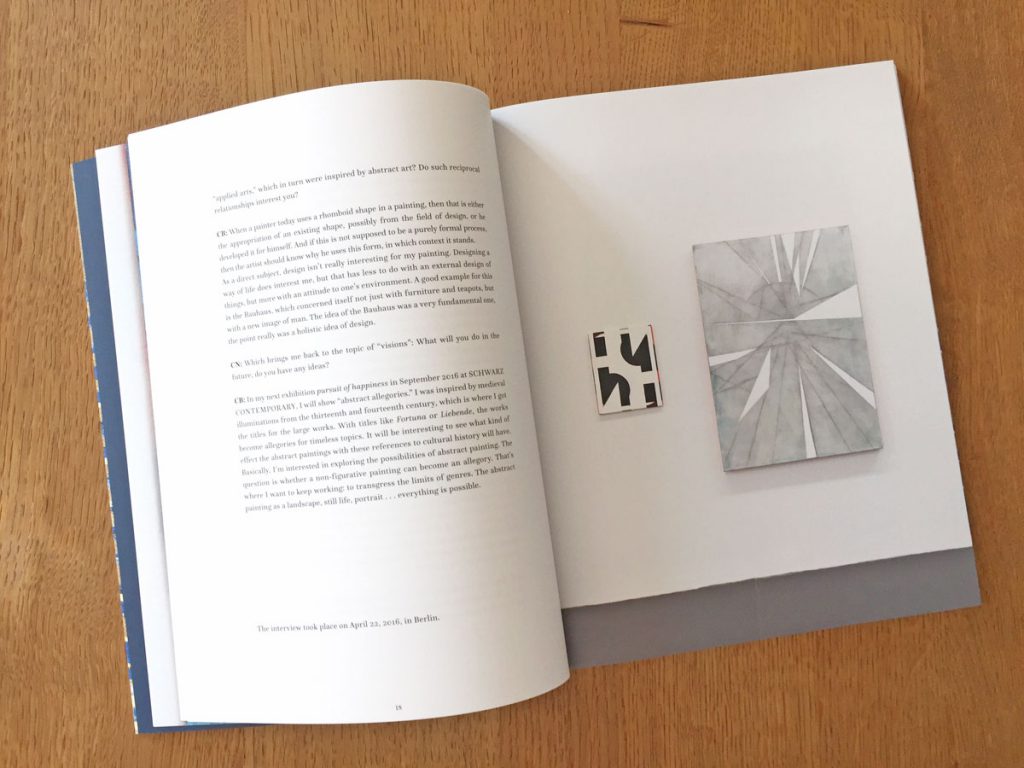
The full interview was published as part of the monography ‚Clara Brörmann‘. You can find more about the book on our website.
Schreibe einen Kommentar